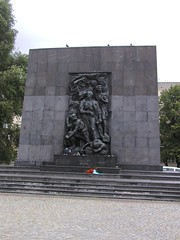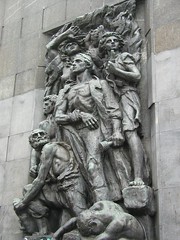The bottom line is that it was a good use of my time (only a three hour commitment), achieved my goal of identifying the city’s main sightseeing spots, and was only 130 PLN (zloty), or USD 35.00. Invariably, though, I seem to have a real oddball for my tour director. My luck ran true once again. This gentleman, while being very nice and trying very hard, told the worst jokes…over and over again. I began to feel uncomfortable for him, they were that bad.
There are a few areas that are indeed worth spending some time in: Warsaw’s Old Town, The Royal Route (which originally was the site of all the aristocratic homes and palaces, but today is the home of several embassies, museums, and art galleries), and the Jewish Ghetto. My afternoon tour did not allow much exploration or dilly-dallying around, which is OK because Buddy and I will check out in a bit more detail this weekend. Hopefully, the afternoon showers that plagued me on Friday will clear for the rest of the weekend.
I did learn a bit of history about Poland and Warsaw, in particular The Jewish Ghetto. Here is some information that I learned today about that area in Warsaw:
· At the start of WWII, Warsaw had over 1,000,000 inhabitants, with approximately 260,000 being Jews. Today, Warsaw is a city of 2,000,000 people, with approximately 2,000 Jews.
· The Jewish Ghetto was the area that the Nazis created in 1939; Jews were forced from their homes throughout Warsaw and relocated to this part of the city. A wall was erected around the Jewish Ghetto, separating the Jews from the rest of the Polish people. Guards were posted at all entrances; only those people working in labor camps were allowed to exit the Ghetto on a regular basis. At the height of the Jewish Ghetto (about 1944), there were over 600,000 people crammed into the designated ghetto area; approximately 7 people lived in one room.
· As the Nazis shifted their strategy from the ghettos to the death camps, Jews were once again forced to leave their homes in the ghetto and board trains for either Treblinka or Auschwitz, under the pretense that they were being sent labor camps. Throughout my tour today, I kept thinking about the movie The Pianist; it was as if I was reliving the experience of the main character as I was touring the area. Jews were shipped out of the ghetto at a rate of 5,000 per day. As the ghetto began to decrease its inhabitants, the Nazis moved the ghetto walls in, so that the space per person continued to be roughly the same.
· Towards the early part of 1944, a few hardy souls banned together to fight when the Nazis invaded the ghetto area to remove the last few people...known as the Warsaw Uprising. Eventually, the Nazis were too much for them, and many died in a suicide pact. Hitler apparently was so angry at this turn of events that he ordered Warsaw to be blown up…house by house with dynamite.
· Today, there is nothing left of the Jewish Ghetto, as most of Warsaw was blown up by the Nazis in 1945. There is a monument to the memory of those Jewish men and women who lived in the area, as well as a monument on the site of the railroad station where the Jews were loaded into railroad cars.


For that matter, nearly all of Warsaw has been rebuilt since 1945. When I say rebuilt, I mean literally rebuilt from the ground up. Tomorrow, I’ll share more about the Old Town area, and the reconstruction efforts since WWII.


No comments:
Post a Comment